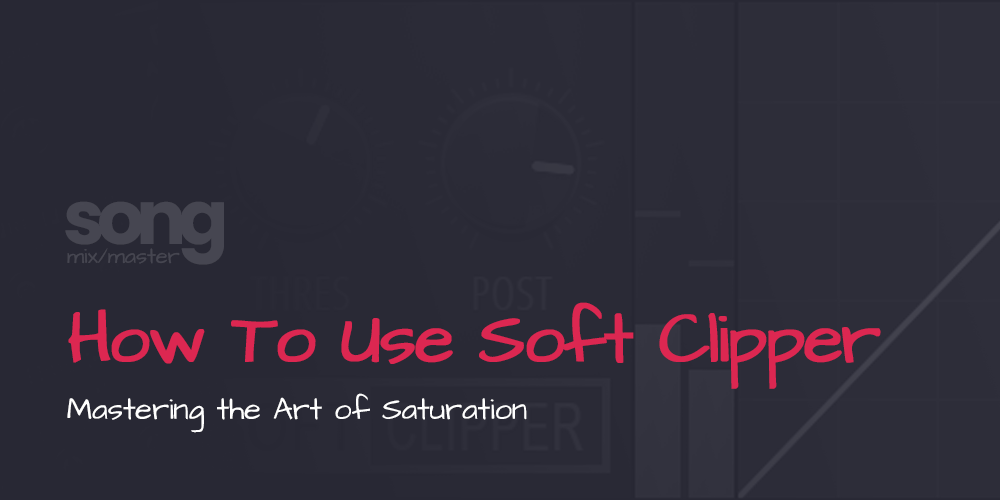As an experienced audio engineer, I’ve had the pleasure of working with a wide range of artists and genres. One tool that often finds its way into my mixing and mastering process is the soft clipper.
A soft clipper can be a game-changer when used correctly, adding warmth, character, and control to your audio mixes. In this article, I’ll walk you through the ins and outs of using a soft clipper effectively in audio mixing.
Also read: 5 Common Mistakes to Avoid in DIY Audio Mixing and Mastering
Understanding the Soft Clipper
Before we discuss the practical aspects, it’s essential to understand what a soft clipper does. Essentially, a soft clipper is a form of dynamic range compression that rounds off the peaks of audio signals more subtlely and musically than hard audio clipping.
A soft clipper is designed to gently limit the audio signal when it exceeds a specified threshold, rather than creating harsh, square-wave-like distortion. This controlled saturation can be used to enhance individual tracks, add character to instruments, and even shape the overall sound of your mix.
Step 1: Inserting the Soft Clipper
In your digital audio workstation (DAW), insert the soft clipper effect as an insert on the audio track (in the mixer) you want to process. Most DAWs support soft-clipping plugins in various formats (VST, AU, etc.), like the Fruity Soft Clipper from FL Studio. Once inserted, you’ll typically see controls for threshold, drive, mix, and sometimes additional parameters like attack and release.
Also read: Best Soft-Clipper Plugins for Mixing and Mastering
Step 2: Setting the Threshold
Start by adjusting the threshold control. This determines at what level the soft clipping begins to take effect. Begin conservatively, as pushing this too far can lead to excessive distortion. The goal is to maintain control while adding character.
Step 3: Adjusting the Amount of Clipping
Next, you’ll want to tweak the drive or amount control. This controls the intensity of the audio clipping. Gradually increase it until you achieve the desired saturation or distortion. Listen closely and trust your ears – sometimes, a little goes a long way.
Step 4: Monitoring the Output Level
Keep an eye on the output level after applying the soft clipper. You may need to use a gain control or adjust the output level of the clipper itself to ensure the processed audio doesn’t clip on the master bus. Maintaining a balanced output is crucial.
Step 5: Finding the Sweet Spot
Now comes the artistic part. Listen carefully to how the soft clipping affects the sound. You’ll notice that it can add harmonics, warmth, and excitement to the audio. This can help make individual instruments or vocals more prominent and dynamic within the mix. Experiment to find the sweet spot that enhances the audio to complement the song.
Step 6: Balancing with Dry/Wet Mix
Many soft clippers allow you to blend the processed (wet) and unprocessed (dry) signals. Adjust this mix control to balance the amount of clipping with the original sound. This is particularly useful when you want to preserve some of the original dynamics while adding character.
Step 7: Automation and Creative Applications
Consider automating the soft clipper settings over time for dynamic effects. For instance, you might increase the clipping during a chorus to add energy to a track or use it to create distinctive transitions within a song.
Step 8: Checking for Phase and Artifacts
While soft clippers are generally gentle, it’s essential to keep an ear out for phase issues or any unwanted artifacts that can sometimes result from clipping. Use your ears and waveform/phase analysis tools to ensure the audio remains clean and coherent.
Step 9: Bypass and Compare
Regularly bypass the soft clipper to compare the processed and unprocessed sounds. This will help you gauge the impact of the effect and make necessary adjustments. Sometimes, a subtle touch can make all the difference.
In the hands of an experienced audio engineer, a soft clipper is a powerful tool for enhancing your mixes. It lets you control peak levels, add warmth, and create a harmonically pleasing saturation effect.
Remember that the key to success with soft clipping lies in careful listening and experimentation. Trust your ears, use it creatively, and soon you’ll be mastering the art of saturation in your audio mixes like a pro.


Disclaimer: Any references to any brands on this website/webpage, including reference to products, trademarks, brands and companies, are provided for description purposes only. We don't have any association with or endorsement by these brands or companies. Some of the links on our blog may be affiliate links. This means if you click on these links and make a purchase, we may earn a commission at no extra cost to you.
Need Professional Mixing & Mastering?
You may also like to read...
Review: Scaler EQ by Plugin Boutique – The Harmonic Master
The Role of Compressor Plugins in Audio Mixing & Mastering
Analog Vs. Digital Summing – Uncovering The Audio Debate
Mastering for Spotify: Achieving the Perfect LUFS Level
How To Do Parallel Compression in FL Studio
Antares Auto-Tune vs. Waves Tune Real-Time – Which is better?